Those Who Served:
|
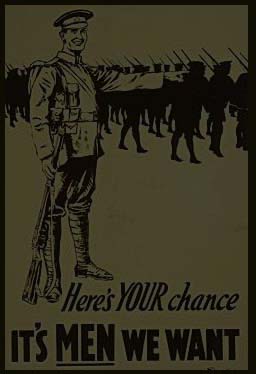 |
The First World War - the "Great War" began
when Britain declared war on Germany on the 4th
August 1914. By the time the war ended at 11 o'clock on the eleventh day
of the eleventh month in 1918 - Armistice Day - 947,000 soldiers of the
British Empire had been killed. The men of the Barnes family played
their part in this 'war to end wars'. Their military service records
were destroyed by bombing in 1940, however other records do exist and
from those and other sources, as well as family recollections we can present their
stories. Follow the links on the page for more
information. |
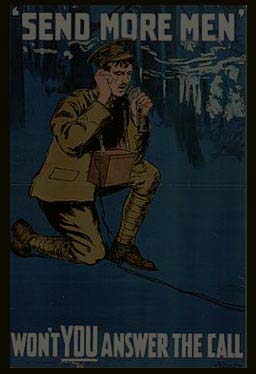 |
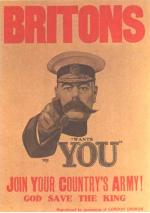 |
|
Charles George Thomas Barnes:
Gunner, Royal Field Artillery (Territorial Force)
|
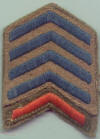 |
 |
 |

Medal Card |
Charles George Thomas Barnes enlisted on
the 29th August 1914, twenty-five days after war was declared - he was
19 years old. He joined
up in the West Sussex seaside town of Worthing (he was living at number 12
Paragon Street - demolished in 1961, now shops, car park and bowling alley) as
Gunner 1597 in the 1/2nd Sussex, Royal Field Artillery (Territorial Force), part
of the 1st Home Counties Brigade, 44th Division. The 2nd Sussex was
stationed in Brighton with the 1st Sussex at the time. In 1916, the 1/2nd Sussex
became 'B' Battery and the other batteries were renamed also; the 1/1st Sussex
became 'A' Battery, the 1/3rd Sussex the 'C' Battery. Charles' medal index
card states that he entered the "Asiatic" theatre of war on the 9th December
1915, but this may be incorrect as his discharge papers show that he had one red
chevron and four blue; the red chevron indicating service overseas in 1914 and
the 1st Home Counties Brigade departed to India on the 29th October 1914 to be
attached to the 5th (Mhow) Division of the Indian Army (there are photo's taken
in Mhow in 1915). The four digit TF numbering caused problems when soldiers
moved between unit and so in late 1916, early 1917 a new numbering scheme was
introduced and Gunner 1597 Barnes C.G.T. became Gunner
900582. Also in 1916, the 1st Home Counties Brigade became the CCXX Brigade
(220th Brigade) and in 1917 the brigade departed for Mesopotamia where it joined
the 17th (Indian) Division. The batteries were renamed at this time with 'A'
Battery becoming the 1064th Battery, 'B' Battery the 1065th and 'C' Battery the
1066th. Sometime in 1917, the 1065th Battery was broken up and divided between
the 1064th and 1066th Batteries. C. G. T. Barnes served in the 1066th Battery
and possibly the 1064th Battery also (there is a reference to the 1064th Battery
in his Army Pay Book. His Army
Pay Book and Discharge Certificate have been kindly given to me by his nephew
Colin Barnes and scanned images of Charles' Army Pay Book, Discharge and
silver War Badge certificates are included here.
His pay book lists monthly location payments for Baghdad, Jubbulpore,
Messing, Deolol, Ambala and Mesopotamia. The "Soldiers Pay Book" has
printed inside "Army Book 64, modified for use in India" and the
payments dates are from the 3rd October 1917 to the 4th July 1919. This pay book
may have
replaced an earlier pay book but does show Charles' earlier service number, so
may date from before 1917. Also
in the Pay Book is Army Form W3066 where Charles signed for "eqpt,
clothing and necessaries" on the 25th March 1919 at Makina Masus (Iraq,
near Basra). Charles was discharged on the 11th December 1919 - taken
from the Soldiers Pay Book when in Active Duty - "he is discharged in consequence
of surplus to military requirements, having suffered impairment since
entry into the service paragraph 392 (XVIa) Kings Regulations after
serving five years, 105 days in the Colours and nil years and days in
the Territorial Force".
Charles was awarded the
Silver War Badge, number 482934
and the 1914/15 Star, the
British War Medal and the
Victory Medal.
|
William Edward Barnes:
Lance Corporal, 5th Battalion Royal Berkshire
Regiment
|
|
 |
 |

Medal Card |
William Edward Barnes joined the 5th
Battalion, Royal Berkshire Regiment in Reading on the 8th January 1915,
aged 35 and served
in France from the 28th July 1915. The 5th Battalion was a 'service'
battalion formed at Reading on the 25th August 1914 as part of 'K1' -
Kitchener's Army created under Army Order 324 on the 21st August 1914.
William's daughter Olive tells of the time that her father returned on
leave to England, he arrived at Reading Station and penniless had to
walk the seven miles to his home in Riseley. On the 13th October 1915 - shortly after the Battle of Loos - William
took part in a daring raid on the German trenches using Mills bombs. In
the action Lieutenant Roger Thompson Pollard of the 5th Royal Berks was
at first wounded and then killed in action. There is a book,
privately published by Chiswick Press in 1916 and written by A W
Pollard, the brother of Roger Thompson Pollard called "Two Brothers -
Accounts Rendered". The book gives the accounts of the service of two
brothers; Lieutenant Geoffrey Blemell Pollard of the Royal Field
Artillery who was killed in action on the 24th October 1914 at La Bassee
and of Lieutenant Roger Thompson Pollard of the 5th Royal Berkshire
Regiment who was killed in action on the 13th October 1915. The book is
inscribed "To Mr W E Barnes in memory of Roger Pollard AWP Christmas
1919".
William went on to fight in the Battle of the Somme and received a
shrapnel wound to his left arm, which turned gangrene and according to
his daughter Olive he was hospitalised for a long time. He was
discharged under Kings Regulation 392 XVI - no longer physically fit for
war service on the 11th August 1916, however the Silver War Badge Role
of Entitlement also lists the date of 14th September 1918 and specifies
William's age - 40. This may refer to the period of
hospitalisation and account for the 'B' prefix on the Silver War Badge
number which indicates it was issued between September 1918 and December
1919. Although William recovered from his wounds, his left arm remained
weak. William was awarded the Silver War
Badge number B23452 and the 1914/15 Star,
the British War Medal and the
Victory Medal.
|
Ernest John Barnes:
Private, 2nd Battalion East Surrey Regiment
|
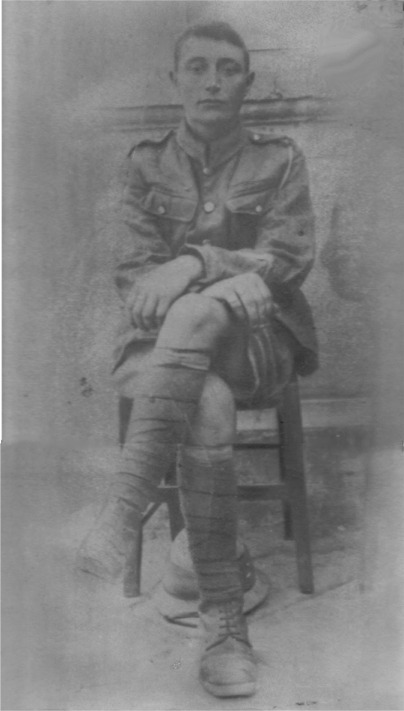 |
 |
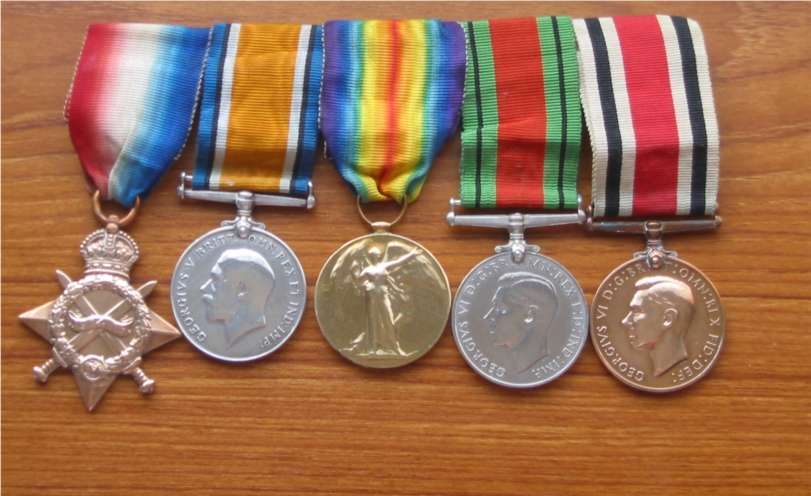 |
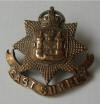 |
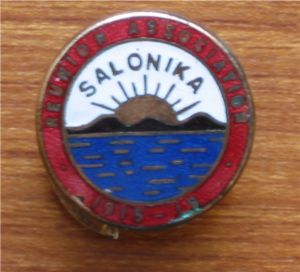 |

Medal Card |
|
|
|
 |
Gallant East Surreys
(1915 Newspaper Article) |
Ernest John Barnes (my grandfather) joined the 2nd Battalion
East Surrey Regiment, part of the 28th Division, 85th Brigade probably in
late 1914 as prior to that the
battalion was in India, not arriving in England until the 23rd December
- we cannot be sure of the actual date of enlistment as his service
records could not be found in the WO363 "Burnt Series" of service
records. He was initially posted to Dover Castle and from
his medal card we know that he arrived in France on the 1st June 1915 as Private
7573, he was just 18 years old. The 2nd Battalion saw action in the Battle of Loos (25th September
- 8th October) before embarking at Marseilles where they proceeded to
Egypt arriving at Alexandria on 30th
October. On the 26th November 1915, the battalion embarked for Salonika
(modern day Thessalonica),
arriving on the 1st December 1915. They had been sent to reinforce the combined
Franco-British force that had landed in Macedonia at the request of the
Greek Prime Minister. Their aim was to help the Serbs in their fight
against Bulgarian aggression and later against the Turks.
The 2nd Battalion was involved in operations in the Struma Valley (Macedonia)
between December 1915 and February 1917 and around Lake Doiran
(Macedonia) between February 1917 and November 1918. The war in Salonika
was regarded as a 'side-show' compared to the Western Front and
the
Allied army was known back home as the "Gardeners of
Salonika" due to the apparent lack of activity and people
would comment "If you want a holiday, go to Salonika".
Despite the view of those at home, life in
Macedonia was far from easy. The British Salonika Force not
only had to cope with the extremes in temperature but also
malaria. In 1916 it was possible to evacuate the most
serious cases. However, with the introduction of
unrestricted submarine warfare in April 1917 this was no
longer possible. Consequently the cases of malaria soared as
the infected men were compelled to stay in Macedonia.
Hospital admissions in 1917 alone were 63,396 out of a
strength of about 100,000 men. By early 1918 the British
were again able to evacuate the worst cases and under the
'Y' scheme nearly 30,000 were evacuated.
Ernest John Barnes was one those that suffered from malaria,
although he was not evacuated.
My father tells of two stories told to him by his father, Ernest John
Barnes, the first is of the time that he was pinned down in a shell hole
for several days surrounded by the bodies of dead Scotsmen*. Without any
food, he saw a small bag attached to the wrist of one of the soldiers
and taking it found some food in it. The other is of the time he was
exchanging rifle fire with a Bulgarian soldier and finding himself out
of ammunition charged the enemy with fixed bayonet, the Bulgarian
promptly pulled out from his tunic pictures of his wife and family" As he would tell later, "one
moment he was trying to kill me, the next he was begging for mercy".
* These were probably soldiers from the 77th Brigade, which included the
Royal Scots Fusiliers, the Cameronians, the Black Watch and the
Argyll and Sutherland Highlanders.
Ernest John Barnes was discharged from military service on the 29th May
1919 and awarded the 1914/15 Star,
the British War Medal and the
Victory Medal. He was a member of the
Salonika Reunion Association This
photograph was taken at the Regimental
Depot in Kingston-Upon-Thames in 1919.
|
Private 721131 Herbert Robert Albert Barnes
2/24th Battalion, The County of London Regiment (The Queen's) (Territorial
Force)
|
 |
 |
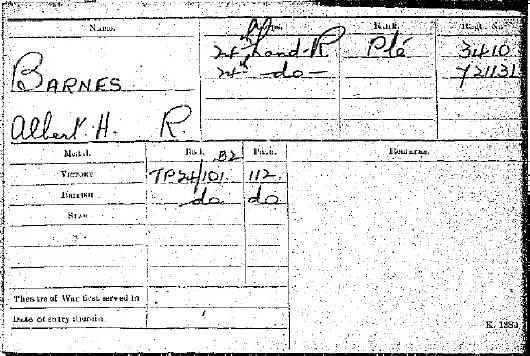
Medal Card |
Herbert Robert Albert Barnes was the son of Thomas George and Annie Barnes, the
grandson of Thomas and Jane Barnes, the cousin of Ernest John and Charles George
Thomas Barnes (see above) and my first cousin two times removed. The search for
H. R. A. Barnes has been a long one and started several years ago when my father
showed me a letter written by his Aunt Violet back in 1996. In the letter Aunt
Violet told of two brothers, one of whom died in the First World War of a
stomach wound, the letter indentified him only as 'Bob'. 'Bob' also appears on
the 1901 census and that lead me to speculate that his name was Robert, however
the 1911 census lists 'Bob' as Herbert Robert Albert Barnes and
cross-referencing with the Commonwealth Grave Commission website shows that a
Private Albert Herbert Robert Barnes of the 24th Battalion, London Regiment died
on the 18th September 1918 and is buried in the Epehy Wood Farm Cemetery in
grave II.B.20.
Herbert Robert Albert Barnes was born on the 26th January 1898 and therefore
only sixteen when war broke out in 1914 - his medal card does not show when or
where he first served overseas but as he was only entitled to the
British War
Medal and the Victory Medal he probably enlisted soon after his eighteen
birthday in 1916. However, his medal card does show his original four digit
service number and the later six digit service number. Re-numbering from four to
six digit service numbers took place late 1916, early 1917 and this fits with an
enlistment early in 1916. The 24th Battalion was of the Territorial Force (hence
the four digit service number) and was split into three; the 1/24th was formed
in August 1914 at 71 New Street, Kennington Park Road and landed at Le Havre on
the 16th March 1915. The 2/24th was formed in Lambeth also in August 1914, moved
to St Albans in March 1915, then to Braintree, May 1915 then onto Sutton Veny in
the January of 1916.
The 2/24th landed at Le Havre in the June of 1916. In the November of 1916 the
60th (2/2nd London) Division of which the battalion was a part of moved to
Salonika (co-incidentally Private Ernest John Barnes of the 2nd East Surreys was
already there) via Marseilles and Malta. The transfer was completed on Christmas
Day 1916. On the 12th June 1917 the battalion moved to Egypt to take part in the
Palestine campaign and in the following year returned to France, going via
Taranto (30th July). The 60th Division was reformed in mid-1918 as a division of
the Indian Army with many of its battalions, including the 2/24th transferred to
the 198th Brigade 66th (2nd East Lancashire) Division on the 15th July 1918. The
2/24th was then transferred to the 173rd Brigade, 58th (2/1st London) Division
on the 11th September 1918 in readiness to take part in the Battle of Epehy on
the 18th September. Read about the
preparation for the
battle and the account of
the battle from the battalion War Diary.
Private 721131 Herbert Robert Albert Barnes died on the 18th September 1918 and
is buried in the Epehy Wood Farm Cemetery in grave II.B.20. He was twenty years
old. Epehy is a village between Cambrai and Peronne about 18 kilometres
north-east of Peronne. Epehy Wood Farm Cemetery is a little west of the village
and on the north side of the road to Saulcourt. The 2/24th remained part of the
173rd Brigade until the Armistice.
|
Private G/21135 Robert Harry Barnes:
7th Battalion The Queens (Royal West Surrey) Regiment
|
|
 |

Medal Card |
I had thought that
Robert Harry Barnes was the cousin of Ernest John Barnes and
Charles George Thomas Barnes but it turns out this is not the case. If
he is family then it is from a part of the family that I have no
knowledge of. But nevertheless, his story is worth the telling. The 7th Battalion Queen's (Royal West
Surrey Regiment) was a service battalion raised in Guildford on the 11th
September 1914 under Army Order 382 as part of Kitcheners New Army 'K2'. The battalion was
attached to the 55th Brigade, 18th (Eastern) Division and served in
France from May 1915. Robert's medal card shows that he was awarded the
Victory Medal and the British War Medal but not the 15 Star - therefore
his service must have started sometime in 1916. In the middle of
January 1917 the 7th Queen's were back to the front line that they had
left in November. On 17th February 1917 the 18th Division fought at Boom
Ravine (near Miramont), with the 55th Brigade and the 7th Queen's in
reserve. Although not deeply involved in the actions of February, the
battalion lost 10 men killed in action, 2 officers and 48 other ranks
wounded and 41 men missing. Robert Harry Barnes was one of the missing - killed on the 27th February 1917
on the Somme he has no
known grave. His name is recorded on the Thiepval Memorial.
7399 officers, NCOs and men of the Queen's were
killed in the First World War.
In 1959 the regiment was amalgamated with the East Surrey Regiment to
form the Queen's Royal Surrey Regiment. In 1966, The Queen’s Royal
Surrey Regiment became part of The Queen’s Regiment and as a result of
further reductions in infantry regiments in 1992, The Princess of
Wales’s Royal Regiment was formed by the amalgamation of The Queen’s
Regiment and The Royal Hampshire Regiment. |
Others that Served:
|
|
|
|
|
|
4722 Private (later Corporal) William
Leach:
9th Battalion Royal Fusiliers
|
|
|

Medal Card |
|
Private William Leach served with the 36th Brigade
12th Eastern Division arriving in France on the 1st June 1915, the same day
as Private 7573 Ernest John Barnes and in the same division as William
Edward Barnes (5th
Battalion, Royal Berkshire Regiment). Perhaps William path crossed that
of Ernest John Barnes and William Edward Barnes, either during the
journey to the Western Front or in subsequent service on the front line.
The 9th Royal Fusiliers was a 'service' battalion raised as Kitcheners
'K1' army William would have fought in the Battle of the Somme in 1916
and would serve in France until Armistice Day. His medal card doesn't
show when he was discharged from the service but we do know that he was
home from the front and still in uniform in January 1918 when he married my
grandmother. William was awarded the
1914/15 Star,
the British War Medal and the
Victory Medal. He survived the war, but died at the age of 33 in the
March of 1924. His marriage and death certificates can be found on the
Certificates page.
|
Harold James Druett:
Queen Mary's Own 18th Hussars
|
 |
Harold James Druett married Elizabeth Freda Victoria Barnes in 1925, but sadly
very little is known of his service in the First World War. Jeremy Tenniswood of
http://www.militaria.co.uk/default.asp has very kindly identified the cap
badge and shoulder titles as that of the Queen Mary's Own 18th Hussars and it is
said (in the family) that he served 'in tanks' and that tallys with service in
the 18th Hussars - cavalry regiment that would swap their horses for tanks later
in the war. I have been unable
to find a Medal Index Card entry for him, despite extensive searching using
different spelling for the surname. Even a search on the 18th Hussars has failed
to find an entry for Harold Druett. This may indicate that he did not serve
overseas. Perhaps Harold was too young to enlist earlier in the war and
was conscripted towards the end. Unfortunately, this cannot be confirmed as his
date of birth is unknown, but he may have been born in 1898 as the marriage
certificate states his age, as at September 1925 as 26.
The 18th Royal Hussars (Queen Mary's Own) was a
cavalry regiment , first formed in 1759. It saw service for two centuries, before being
amalgamated into the
13th/18th Hussars in 1922. The regiment was first raised as the 19th Regiment of (Light) Dragoons in 1759,
renumbered the 18th Regiment of (Light) Dragoons in 1763 and briefly the 4th
Regiment of Light Dragoons in 1766 before settling on the 18th in 1769. In 1805
it took the title of the 18th (King's Irish) Regiment of (Light) Dragoons, named
for George III, and designated as hussars in 1807, becoming the 18th (King's
Irish) Regiment of (Light) Dragoons (Hussars). It was disbanded in Ireland in
1821.The regiment was reformed in 1858, as the 18th Regiment of (Light)
Dragoons from a nucleus taken from the 15th Hussars, and renamed the
18th Hussars in 1861. In 1903 it was named the 18th (Princess of Wales's
Own) Hussars, for Princess Mary, being re-titled the 18th (Victoria
Mary, Princess of Wales's Own) Hussars in 1905 and the 18th (Queen
Mary's Own) Hussars in 1910 to mark her coronation as Queen Consort.
After service in the First World War, the regiment was renamed as the
18th (Queen Mary's Own) Royal Hussars in 1919, then the 18th Royal
Hussars (Queen Mary's Own) in 1921, and was amalgamated with the 13th
Hussars to form the 13th/18th Hussars the following year. |
David Cyril Butterworth:
David Cyril Butterworth married Annie May Barnes and is my granduncle by
marriage. He was born in New Mills, Derbyshire in 1897 but had emigrated with
his parents to Canada, joining the
1st Depot
Battalion, British Columbia Regiment in the May of 1918.
Particulars of
Recruit. This document is the call-up paper for the Canadian Army
and describes the recruit in great detail. From this document we know
that David was 5 foot 6 and 1/2 inches, of fair complexion with fair
hair and blue eyes, had a scar on the right side of his neck and that
the second toe of each foot was missing. Also listed is his address,
place of birth (England) and the address of his next of kin (his
mother).
He married Annie May Barnes on the 2nd May 1919 in St. Marys Church, Balham.
Their daughter Sybil Ena was born later that year. A second daughter, Freda
Eileen was born in Vancouver, British Colombia, Canada in February 1924.
|
|
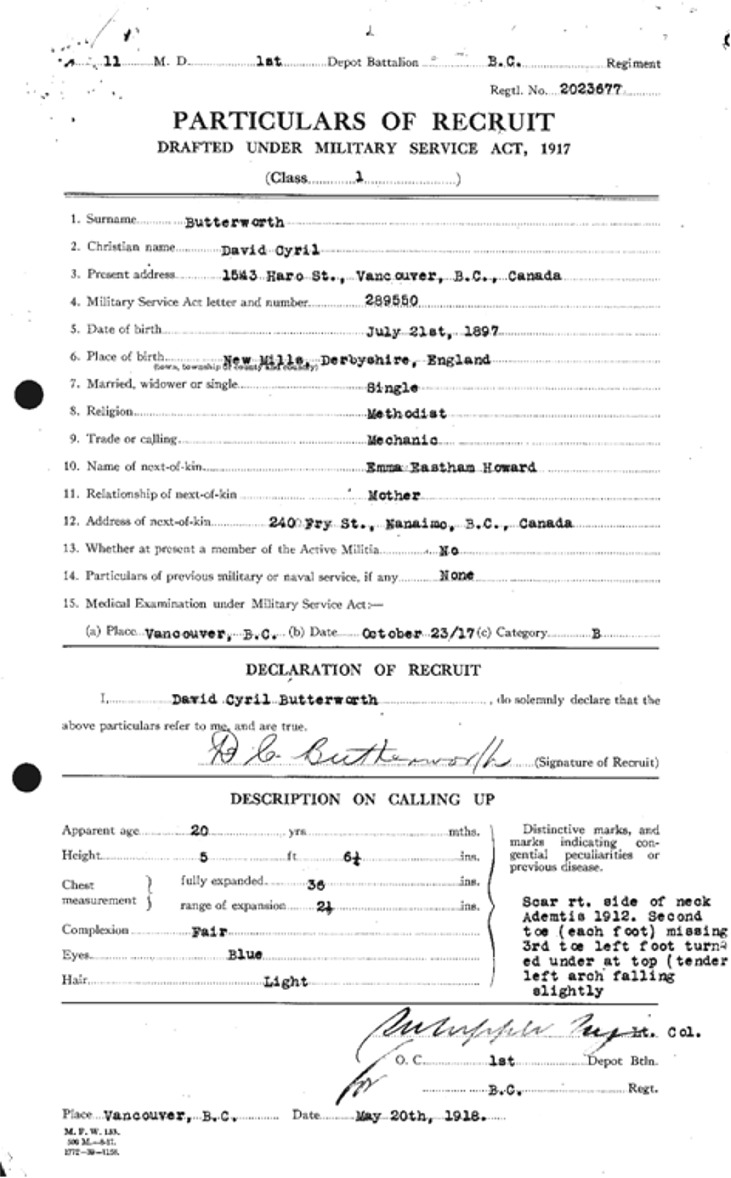 |
The Gosling Brothers:
The Goslings are related to the Barnes family, Catherine Elizabeth Gosling
married Edward Wooldridge, their daughter Olive Kathleen Barnes married Ernest
John Barnes. Catherine and Edward are my great-grandparents. The eight
Gosling brothers that served in the Army and Royal Navy are cousins. For more information
about the Gosling brothers, click
here.
The information regarding the Goslings kindly provided by Janice Walker. |
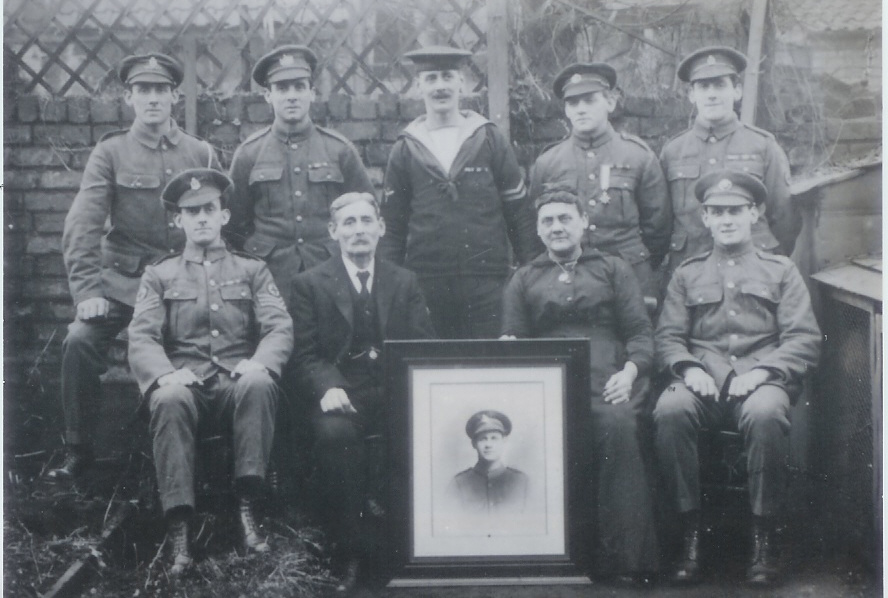 |
|
|
|
|
|
| |
 |
|
|
|
|
|

















